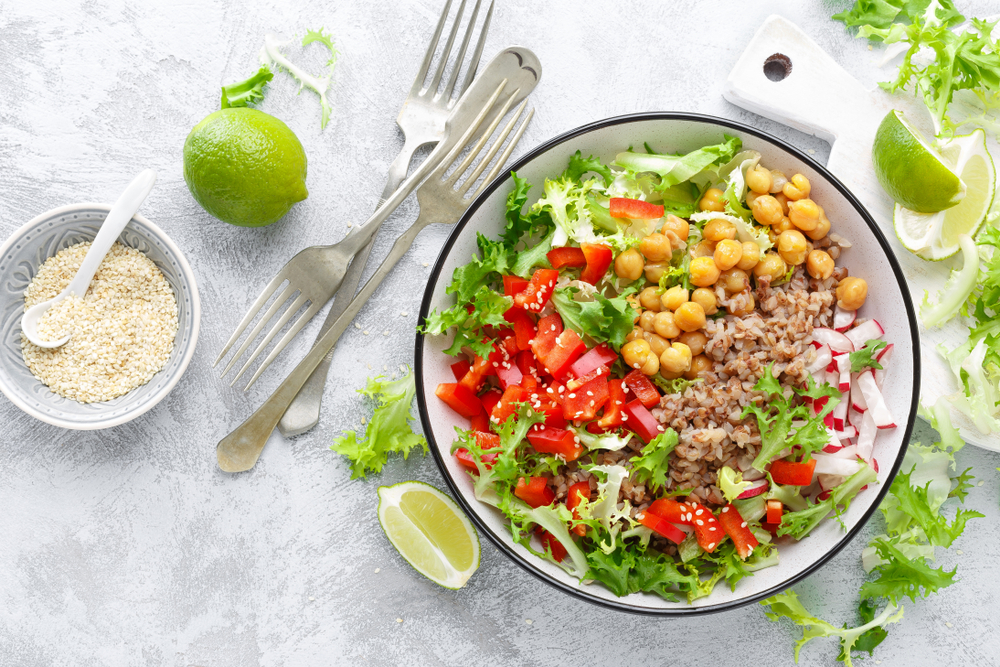
If you have been a vegetarian for more than a decade as I have, you are probably familiar with both historical and present-day trending plant proteins. Old school products like Tofurky were often created to mimic the specialty meats that vegans and vegetarians could not have (like burgers, pizza, and Thanksgiving turkey). The plant-based proteins of today are similar—have you heard of the Impossible Burger?
However, consumer demand for these products has changed quite a bit due to health and wellness trends, and diets like Paleo, Keto, gluten-free, and low-FODMAP. Where we used to see mostly soy-based alternatives, there is now a much wider variety.
The largest proteins at a retail level now include: Coconut, Almond, Pea, Brown Rice Flour, Quinoa, Lentils, Cashews, Oats, and Soy.
You will find these proteins as the number one ingredient in crackers, yogurt, milk, pasta, cookies, frozen burgers, frozen pizza, ice cream, faux beef, chicken and cheese—the list goes on! The one thing most of them have in common is the variety of ways they can be used.
However, some of the plant-based proteins don't supply as much protein as you would expect. For instance, my favorite almond flour crackers require you to eat 17 crackers to get 3 grams of protein. One cup of coconut milk provides 0 grams of protein. Nevertheless, these plant-based products do contain some essential nutrients.
So what are the newest plant-based proteins popping up at your local supermarket? Check these out.
Jackfruit – I'm guessing not a lot of the U.S. population is eating jackfruit as a meat substitute yet. I discovered The Jackfruit Company’s "Lightly Seasoned Jackfruit" in the freezer section during my last visit to Whole Foods. This product looks like the chicken you would sauté and add to a salad or pasta dish. Jackfruit's appeal is that it is gluten and soy-free with a good amount of fiber and potassium. When it's young, it's great for savory dishes, when it's ripe, it is perfect for smoothies and frozen desserts. The Jackfruit Company has loads of other products, including meal kits and the better known "Smoked Pulled Jackfruit."
RELATED: The Influence of Simple and Minimalist Lifestyle on Food and Drink
 Amongst the ever-expanding yogurt market, the new kid on the block contains cassava. Cassava is having its day at the market right now! Chips, crackers, cookies, energy bars, tortillas, and one of my favs the LAVVA brand yogurt. It tastes like a dessert to me! Cassava is rich in calcium, magnesium, potassium, and vitamin C. The root is an "affordable source of carbohydrates. It can provide more calories per acre of the crop than other cereals, which makes it a very useful crop in the developing world."- Medical News Today. As suggested by scientists, cassava helps boost gut health. It is also exceptionally versatile as it can also be used to make paper, fabrics, and even plywood.
Amongst the ever-expanding yogurt market, the new kid on the block contains cassava. Cassava is having its day at the market right now! Chips, crackers, cookies, energy bars, tortillas, and one of my favs the LAVVA brand yogurt. It tastes like a dessert to me! Cassava is rich in calcium, magnesium, potassium, and vitamin C. The root is an "affordable source of carbohydrates. It can provide more calories per acre of the crop than other cereals, which makes it a very useful crop in the developing world."- Medical News Today. As suggested by scientists, cassava helps boost gut health. It is also exceptionally versatile as it can also be used to make paper, fabrics, and even plywood.
Seed based proteins are going to continue to trend. Chia and hemp have been around a while but also look for more products with sunflower, pumpkin and sesame seeds as the primary source of protein.
 The weirdest of them all would be cricket-based proteins. Not a plant, but an alternative source that could contribute in a small way to the impact animal agriculture has on the environment. Already available is cricket flour, and at 25g of protein for 1/3 a cup, it has appeal.
The weirdest of them all would be cricket-based proteins. Not a plant, but an alternative source that could contribute in a small way to the impact animal agriculture has on the environment. Already available is cricket flour, and at 25g of protein for 1/3 a cup, it has appeal.
My plant-based trend predictions:
Tiger Nuts – Right now there are tiger nut flours and the actual tiger nuts at the market for purchase. There are three different varieties: brown, yellow, and black, and they are rich in nutrients. The nutrients vary based on the type. Since it is recommended as a gluten-free alternative flour, I can see it expanding into many other food categories (protein being one of them).
Sacha Inchi Seeds – One of my favorite sustainable superfood companies, Imlak'esh Organics, introduced me to these yummy seeds. As stated by the company, "This amazing seed is packed with more complete protein and healthy Omega 3 oils than any other nut or seed. In fact, it is one of the best vegan sources of this essential fatty acid on the whole planet!" The seed is high in protein, calcium, and iron, and is available in its natural form as well as protein powder, oil, and some beauty products.
Pili Nut – The Lavva yogurt I previously mentioned contains the pili nut. Lavva’s website states, "Unlike almonds, Pili nuts require very little water and create zero waste. Besides using nuts for food and oil (and yogurt), the trees' shells and bark are used for furniture, and the sap is used in cosmetics." Again, another multiuse plant-based product that tastes good!
 As I was finishing up this article, Kentucky Fried Chicken announced they would be the first fast-food chain to test Beyond Meat's plant-based chicken. It's humorously called a "Kentucky Fried Miracle!" Now, that’s a big deal!
As I was finishing up this article, Kentucky Fried Chicken announced they would be the first fast-food chain to test Beyond Meat's plant-based chicken. It's humorously called a "Kentucky Fried Miracle!" Now, that’s a big deal!
The plant-based protein market has expanded immensely since the days of soy-based tempeh and seitan. Tempeh comes from the Indonesian island Java and dates back as far as 1815 and seitan, dates back to ancient China. These were some of our original faux meat products in the U.S., and good ones at that. I wonder if our younger generations even know about them now!






